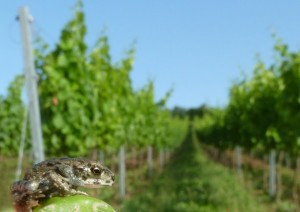In this post, Kathrin Theissinger presents her recently granted project on the development of landscape ecological models for the effects of chemicals on amphibians in which a 3-year PhD position is available.
Project title: Amphibians in agricultural landscapes: chemical landscape fragmentation implemented in a habitat modeling approach

Juvenile European green toad (Bufo viridis) are present in vineyards in Rhineland-Palatinate (photo by C. Brühl)
The underlying concept of landscape ecology and metapopulation theory is the separation of occupied habitat patches by a matrix (space) of unsuitable habitat. The composition of this unsuitable habitat matrix can influence the population structure within the occupied patches. A suitable model system to investigate matrix variation effects are amphibians in the agricultural landscape, since they breed in discrete wetlands and often have to cross unsuitable crop land to migrate from terrestrial to aquatic habitats for reproduction. Habitat fragmentation in the agricultural landscapes is not only due to visible barriers (infrastructure); also pesticides play a crucial role in this context. A spatio-temporal overlap of pesticide applications with the terrestrial activity phase of amphibians is demonstrated for many crops. Although pesticide exposure of terrestrial amphibians migrating and foraging in agricultural fields is likely, and recent laboratory studies showed that some commonly used pesticides are highly toxic to terrestrial amphibians at field application rates, pesticides are not considered as an independent factor in current landscape ecological models. Moreover, a “chemical landscape fragmentation”, i.e., the impact of pesticides on the genetic population structure of amphibians, has to date gained no scientific attention. An indirect method to assess the effects of pesticide exposure on amphibian populations is the use of neutral molecular markers (microsatellites) to analyze the genetic diversity of and gene flow among subpopulation in the agricultural landscape. Our preliminary genetic data suggest that the viticulture landscape has to be considered as migration limiting barrier for the R. temporaria. In this research project we will use a landscape genetics approach to assess the impact of chemical landscape fragmentation in viticulture for three amphibian species (Bufo bufo, Rana temporaria, Triturus helveticus) with varying dispersal abilities. We will measure and compare gene flow rates and genetic diversities among breeding pond populations. We will complement our genetic data with a classical marc-recapture study to investigate the migration direction from the aquatic to the terrestrial habitat. We will conduct interviews to management practices with local wine farmers to collect realistic land use data. Finally, we will implement the genetic and land use data in a habitat modeling approach that can be used to determine the population trend and improve the protection of amphibians in agricultural landscapes.
Potential candidates for a 3-year PhD position on this topic (Beginning November 2015) may send a motivation letter, CV and university certificates to: theissinger@uni-landau.de
Application deadline: October 1st, 2015
